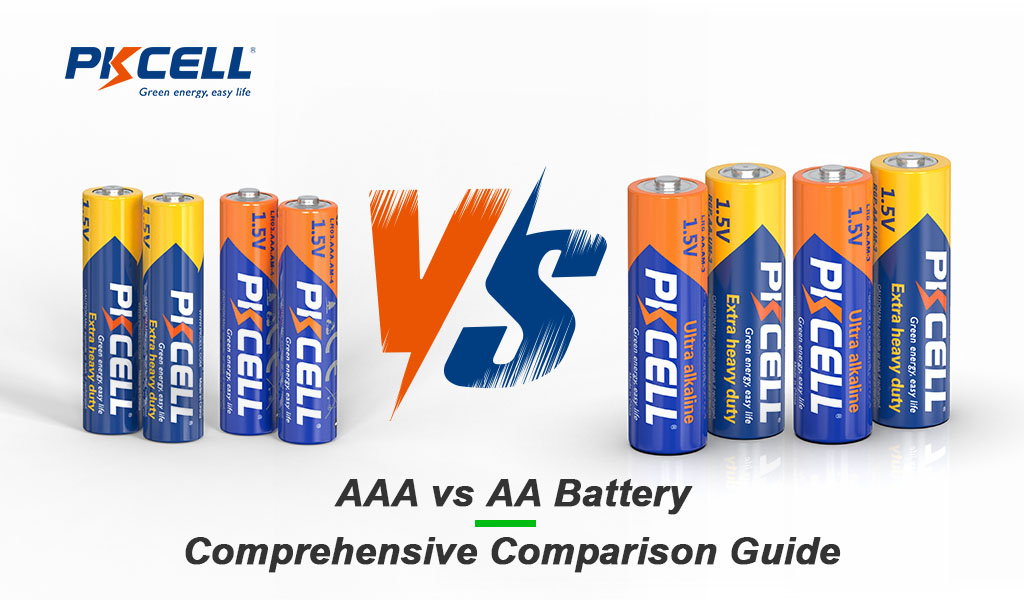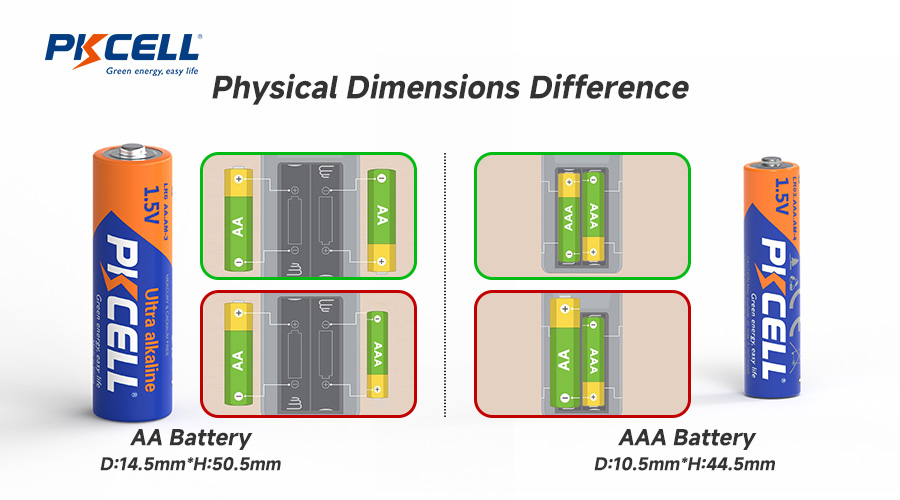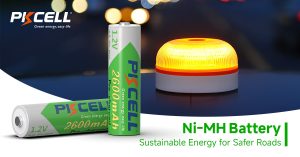
Основные моменты
- AA and AAA batteries are both cylindrical primary (single use) or secondary (rechargeable) cells, widely used in consumer electronics.
- AA batteries are larger (14.5mm diameter, 50.5mm length) than AAA batteries (10.5mm diameter, 44.5mm length), fitting devices with more space.
- AA batteries typically have higher capacity (1000-3000mAh) compared to AAA batteries (500-1200mAh), supporting longer runtime in medium-power devices.
- Both share similar nominal voltages (1.5V for alkaline, 1.2V for NiMH rechargeables) but differ in power output suitability.
- AA batteries suit devices like remote controls and toys; AAA batteries are ideal for smaller gadgets like TV remotes, wireless mice, and portable flashlights.
Введение
AA and AAA batteries are among the most common power sources in household and portable electronics, from remote controls to digital cameras. While they may look similar at first glance, their differences in size, capacity, and performance make them suited for distinct applications. For consumers, product designers, or buyers, understanding these differences is key to choosing the right battery for a device—ensuring optimal performance, avoiding compatibility issues, and balancing cost and efficiency. This guide breaks down the core distinctions between AA and AAA batteries to help you make informed decisions.
Understanding AA and AAA Batteries
Both AA and AAA batteries are cylindrical, standardized cells used to power low-to-medium energy devices. They are available in two main types: single-use alkaline (disposable) and rechargeable NiMH (nickel-metal hydride). Their names (AA, AAA) derive from size standards set by industry bodies, with “AAA” indicating a smaller form factor than “AA.” Choosing the wrong size can lead to poor fit, reduced device performance, or even damage—for example, a loose AAA battery in an AA-sized compartment may rattle, causing intermittent power loss. While their chemical compositions (alkaline or NiMH) are often similar, their physical and performance traits diverge significantly.
The Basics of AA Batteries
AA batteries are the larger of the two, with a standard diameter of 14.5mm and length of 50.5mm. They are versatile, available in both alkaline (single use) and NiMH (rechargeable) variants.
Alkaline AA batteries typically have a nominal voltage of 1.5V, while rechargeable NiMH AA batteries operate at 1.2V. Their capacity ranges widely: alkaline AA batteries usually offer 1000-2700mAh, while high-quality NiMH versions can reach 2000-3000mAh. This higher capacity makes them ideal for devices that draw moderate power over extended periods, such as toys, portable radios, electric shavers, and digital cameras.
Click Here to quote for AA Alkaline batteries
Click Here to quote for AA Ni-MH batteries
The Basics of AAA Batteries
AAA batteries are smaller, with a diameter of 10.5mm and length of 44.5mm, about 30% smaller than AA batteries. Like AA batteries, they come in alkaline (1.5V) and NiMH (1.2V) options.
Their capacity is lower due to their smaller size: alkaline AAA batteries typically range from 500-1000mAh, while rechargeable NiMH AAA batteries offer 600-1200mAh. This makes them better suited for low-power, compact devices where space is limited, such as TV remotes, wireless computer mice, small flashlights, and portable gaming controllers.
Click Here to quote for AAA Alkaline batteries
Click Here to quote for AAA Ni-MH batteries
Key Differences Between AA and AAA Batteries
The primary differences lie in size, capacity, and suitability for specific devices—traits that directly impact how they perform in real-world use.
Физические размеры и совместимость
Size is the most obvious distinction. AA batteries’ larger dimensions (14.5mm x 50.5mm) require more space in device compartments, while AAA batteries (10.5mm x 44.5mm) fit into slimmer, more compact designs.
Device manufacturers design battery compartments to match specific sizes, so an AAA battery cannot reliably replace an AA battery (it will be too small, leading to loose connections), and vice versa (an AA battery will not fit into an AAA compartment). Always check the device manual for size requirements.

Мощность и выход энергии
AA batteries’ larger volume allows them to store more energy. For example, a high-capacity alkaline AA battery (2700mAh) can power a toy car for 4-6 hours, while an AAA battery (1000mAh) in the same device would last 1-2 hours.
Discharge rates (how quickly energy is released) are similar for both when chemistry is the same (e.g., alkaline or NiMH), but AA batteries’ higher capacity means they sustain power longer in devices with steady energy demands (like a portable fan), whereas AAA batteries excel in devices with brief, low power uses (like a remote control button press).

Comparison Table: AA vs AAA Battery
| Характеристика | Батарейка AA | AAA Battery |
| Диаметр | 14.5mm | 10.5mm |
| Длина | 50.5mm | 44.5mm |
| Номинальное напряжение | 1.5V (alkaline); 1.2V (NiMH) | 1.5V (alkaline); 1.2V (NiMH) |
| Диапазон производительности | 1000-3000mAh | 500-1200mAh |
| Типичная скорость разряда | Moderate to high | Low to moderate |
| Общие приложения | Toys, cameras, shavers | Remotes, mice, small flashlights |
Плюсы и минусы каждого типа батарей
Pros and Cons of AA Batteries
– Pros: Higher capacity for longer runtime; versatile for medium-power devices; widely available; rechargeable versions offer cost savings over time.
– Cons: Larger size limits are used in compact devices; alkaline variants generate more waste when disposed of; heavier than AAA batteries.
Pros and Cons of AAA Batteries
– Pros: Compact size fits small devices; lightweight; sufficient for low-power needs; affordable and easy to find.
– Cons: Lower capacity leads to shorter runtime; not suitable for high-power devices; rechargeable versions may have shorter lifespans than AA NiMH.
Заключение
AA and AAA batteries are foundational to everyday electronics, but their differences in size and capacity make them far from interchangeable. AA batteries excel in medium-power, space-available devices, offering longer runtime, while AAA batteries are the go-to for small, low-power gadgets. When choosing, consider your device’s size, power demands, and whether rechargeable (for frequent use) or disposable (for occasional use) options make more sense.
Why Choose Pkcell as Your AAA and AA Batteries Supplier?
PKCELL is a leading B2B battery supplier with over 20 years of experience, offering high-quality AAA and AA batteries for a wide range of industrial and commercial applications. Our AA and AAA batteries, available in both alkaline and rechargeable NiMH versions, deliver reliable, long-lasting performance for everyday and professional devices. With advanced manufacturing, strict quality control, and certifications like ISO9001, CE, and RoHS, PKCELL ensures consistent product quality and dependable supply.
Reach out to us today for custom solutions and bulk pricing.
Часто задаваемые вопросы
Can I use AA batteries in a device designed for AAA?
No. AA batteries are larger than AAA batteries and will not fit into AAA compartments, potentially damaging the device or causing safety risks. Always use the size specified by the manufacturer.
Are rechargeable AA and AAA batteries worth it?
Yes, if the device is used frequently. Rechargeable NiMH AA/AAA batteries can be reused 500-1000 times, reducing long-term costs compared to disposable alkaline batteries. They are ideal for high-use devices like toys or cameras.
Do AA and AAA batteries have the same lifespan?
Alkaline AA batteries generally last longer in storage (5-10 years) than alkaline AAA batteries (3-7 years) due to their larger capacity. Rechargeable NiMH batteries have similar shelf lives (3-5 years when stored properly) but self-discharge more quickly tha

 Перезаряжаемая через USB литиевая батарея
Перезаряжаемая через USB литиевая батарея





